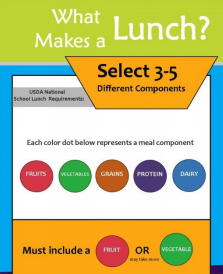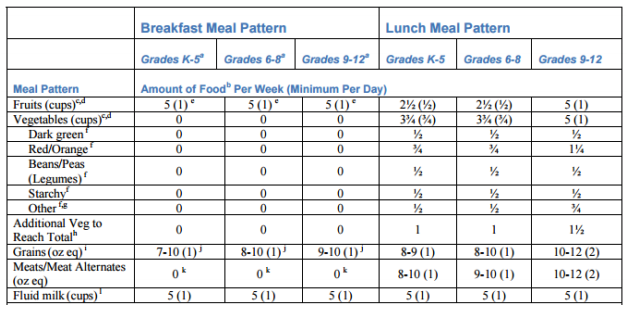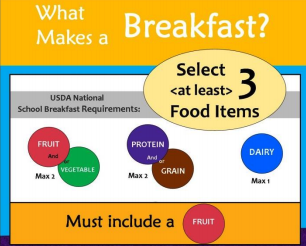A reimbursable meal is a federal formula which helps each district determine whether they receive a monetary reimbursement from the Federal Government for each meal given to students. This does not include adult meals or a second full meal for a student. In order to get that reimbursement, the USDA guidelines and the “Offer versus Serve” program must be followed. The lunch and breakfast programs are a little different, so let’s just start with lunch.
Lunch
At lunch, we are required to “offer” students five components with each meal. Students are required to take three of those five components in order for us to count it as a “reimbursable meal”. Students are also required to take a serving of a fruit or vegetable for us to count it as a reimbursable meal. The components offered are:
 Milk (must be skim or 1% for flavored milk)
Milk (must be skim or 1% for flavored milk)- Meat/meat alternate (meat, cheese, cottage cheese, yogurt, beans/legumes
- Bread/grains (All Grains served must be “whole grain rich” including breading, cookies, cereal, pretzels, etc.)
- Fruit/vegetables (There is a requirement for certain subcategories of vegetables according to their color and nutritional content.)
There are different requirements for different age groups for certain components. For example, at the High School level, we need to offer 10-12 bread/grain servings each week. At the Middle School we need to offer 8- 10 bread/grain servings each week. At the Elementary level, we are required to offer 8-9 servings of bread/grain items each week.

Example 1 of a Reimbursable Lunch: The main item is WG spaghetti and with meat sauce. We put the pasta and meat sauce on the student’s tray. Because it contains a bread/grain component and the meat component, the student then only needs to take a serving of a fruit or vegetable to meet the minimum requirement for a reimbursable meal. They also can take a carton of milk or other item offered as part of the regular lunch, such as one breadstick, and not be charged.
Example 2 of a Reimbursable Lunch: The main item is chili. The chili counts as the meat/meat alternate item. Students would have to take 2 more components for us to count that as a reimbursable meal. They could choose from an 8 oz. carton of milk, a serving of fruit, a serving of vegetables, or a serving of a bread/grain item. Again, one of the three components on their tray has to be a serving of a fruit or vegetable.
Breakfast

At breakfast, we are required to offer four components:
- 1-2 ounce equivalent servings of bread/grain
- ½ cup serving of fruit
- ½ cup serving of 100% juice
- Milk
Students are required to take a serving of a fruit to be counted as a reimbursable meal.
Offer vs. serve at breakfast requires students to take 3 of the 4 components. At minimum, we can count a breakfast as reimbursable if a student takes either milk or one 4 oz. juice serving with a combination of the bread/grain and meat components. Without being charged for an extra item, students can take a carton of milk, 4 oz. juice/fruit and a combination of the bread/grain and meat components.
Example 1 of a Reimbursable Breakfast: Whole Grain Pancakes, ½ cup fruit, and a carton of milk.
Example 2 of a Reimbursable Breakfast: Cereal (1oz container), 1 piece of toast or 1 package of graham crackers, 1 carton of milk, and ½ cup of fruit.
All of our kitchen staff are trained to ensure that each tray holds a reimbursable meal!

